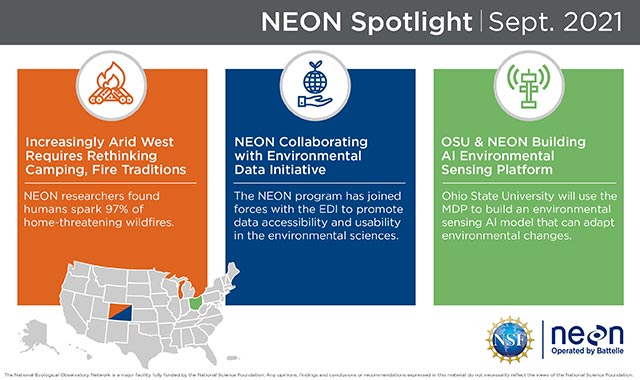September 2021: What’s New with NEON?

This month, we highlight the invaluable impact of the NEON program on the future of science and the way we understand the effect of human interaction with nature. This month’s collection of ecological advances includes a study on humans’ role in causing, and preventing, wildfires; a partnership between NEON and the Environmental Data Initiative; and a first-of-its-kind mobile deployment unit to improve ecological field research.
This Month’s Spotlight
The latest news from NEON includes:
- National Geographic recently shared research by NEON data scientist Nathan Mietkiewicz and Jennifer Balch, Director of University of Colorado’s Earth Lab, reporting humans start 97% of wildfires threatening homes in the United States. Development in wildland-urban areas increased 145% between 1990 and 2015, and the impact of climate change is exacerbating the issue. Because humans cause most wildfires threatening homes, preventing them from occurring with the proper education and awareness is possible.
- NEON collaborates with the Environmental Data Initiative (EDI) to promote data accessibility and usability in the environmental sciences. The joint initiative creates tools, templates, and standards making it easier to synthesize data from the NEON program, the Long Term Ecological Research Network, and other networks and organizations. In addition, the EDI provides an avenue for individual researchers to publish derived data and to interact with data submitted by other researchers.
- The Ohio State University announced it is using NEON’s first mobile deployment platform to build an environmental sensing AI model that can adapt to environmental changes. The tower was designed and built by the NSF’s NEON program, and OSU is the first host of this type of mobile, temporary field site. The main goal of the project is to test the sophisticated computing models needed for research in the field, on sites far from major computer servers. “Being the first mobile deployment of this kind, we need to test how to collect the data, what conditions we may need to tweak, what sensors we need to use and the analytical methods we need to deploy to interpret the data,” explained Tanya Berger-Wolf, director of Ohio State’s Translational Data Analytics Institute and leader of the project.
Sponsored by the National Science Foundation (NSF) and operated by Battelle, NEON is a continental-scale ecological observatory network dedicated to providing high-quality, consistently generated, standardized data that is free and available to all users. By enabling scientists, researchers, and students to address critical questions and understand ecosystem changes over time, the NEON program allows the ecological community to tackle questions and problems at a scale that was not possible before.
You can read about the latest work and research in the NEON Spotlight every month at Inside Battelle, and on our social media channels. For more information about NEON, visit NEONscience.org.
BATTELLE UPDATES
Receive updates from Battelle for an all-access pass to the incredible work of Battelle researchers.